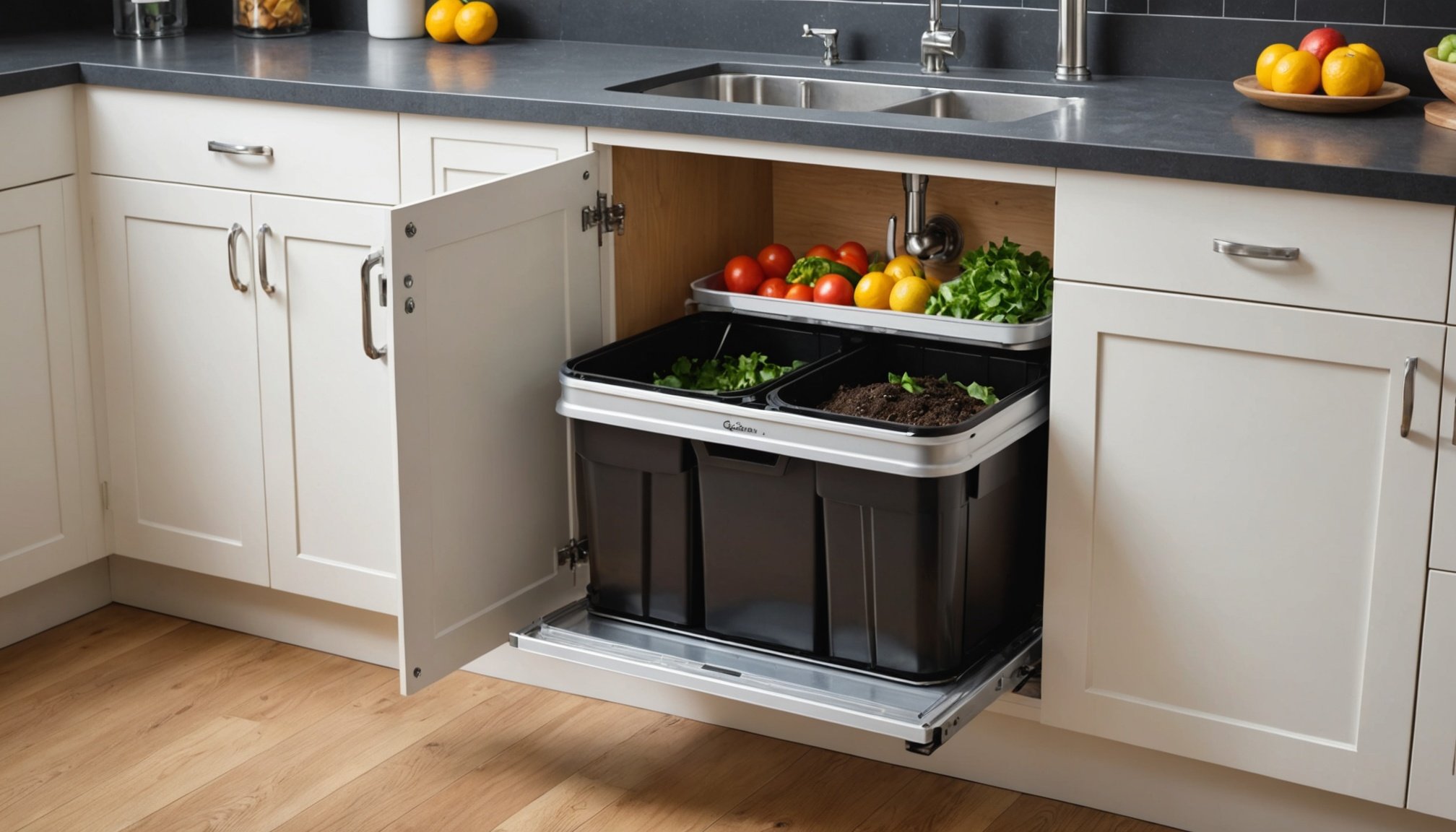Transform your kitchen into an eco-friendly haven with an under-sink composting system. This essential guide unlocks the secrets to seamless installation, catering to UK homeowners eager to reduce waste and enhance sustainability. Experience the benefits of composting, from cutting down on landfill contributions to creating nutrient-rich soil for your plants. Gain practical insights and tips for a successful setup that slices through common misconceptions. Elevate your kitchen’s efficiency and make a positive environmental impact, starting today.
Overview of Under-Sink Composting Systems
Under-sink composting systems are designed to fit seamlessly into urban lifestyles, providing a convenient way to manage organic waste. These systems are installed beneath the kitchen sink, allowing for easy disposal of food scraps, which are then transformed into valuable compost. This process not only reduces landfill waste but also enriches soil, contributing to a healthier environment.
In the same genre : Designing a Stylish Yet Pet-Friendly Kitchen: Tips for Chic Living with Your Furry Friends
In urban settings, the environmental benefits of composting are substantial. By diverting organic waste from landfills, under-sink composting systems help decrease methane emissions, a potent greenhouse gas. Additionally, they encourage sustainable waste management practices, making them an ideal choice for eco-conscious city dwellers.
Composting Regulations in the UK
The UK has specific regulations governing composting systems to ensure safety and environmental protection. These regulations stipulate that composting must not cause nuisance or harm to public health. Compliance with these rules ensures that under-sink composting systems are both effective and environmentally friendly.
Also to discover : How Kitchen Design Influences Resale Value in UK Homes: Unlocking the Secrets to Maximum Return
- Key Points:
- Under-sink composting systems are compact and efficient.
- They offer significant environmental benefits in urban areas.
- UK regulations ensure safe and sustainable use.
By understanding the purpose and benefits of under-sink composting systems, individuals can make informed decisions about incorporating these systems into their homes, ultimately supporting a more sustainable lifestyle.
Choosing the Right Under-Sink Composting System
Finding the ideal composting system for your home can be a daunting task. However, by focusing on key features, you can select a system that meets your needs.
Consider these factors:
- Capacity: Evaluate the volume of waste your household generates. Larger families may require a system with greater capacity.
- Size: Ensure the system fits comfortably under your sink. Measure available space before purchasing.
- Ease of Use: Look for systems with straightforward installation and maintenance procedures.
- Odor Control: Many systems include filters or seals to minimize unpleasant smells.
Comparison of Popular UK Products
In the UK, several under-sink composting systems stand out for their efficiency and design. Here’s a look at some notable options:
| Brand | Capacity | Features |
|---|---|---|
| EcoMaster | 5 liters | Odor filter, compact design |
| GreenBin | 7 liters | Easy-cleaning, durable material |
| CompostPro | 10 liters | High-capacity, advanced filtration |
Kitchen Size and Waste Volume
When selecting a composting system, consider your kitchen's layout and the typical waste volume. Smaller kitchens may benefit from compact models, while larger spaces can accommodate systems with higher capacity. By aligning these factors with your lifestyle, you ensure a seamless integration of composting into your daily routine.
Necessary Tools and Materials for Installation
Choosing the right installation tools and composting materials is crucial for setting up an effective under-sink composting system. This process can be straightforward with the correct preparation and equipment.
Essential Tools for Installation
To ensure a smooth installation, gather the following tools:
- Adjustable wrench
- Screwdriver set
- Pipe cutter
- Measuring tape
These tools will help you secure the system under your sink, ensuring a stable and efficient setup. Properly using these tools minimizes errors and potential damage during installation.
Additional Materials for Effective Composting
Apart from tools, having the right composting materials enhances the system's efficiency. Consider these materials:
- Compostable liners
- Carbon-rich materials (e.g., shredded paper)
- Moisture control agents
These materials aid in maintaining the right balance of moisture and nutrients, crucial for the composting process.
Safety Equipment and Best Practices
Safety should be a priority during installation. Equip yourself with:
- Protective gloves
- Safety goggles
Following best practices, such as reading the system's manual and ensuring all connections are secure, will help avoid accidents. By preparing with the necessary installation tools and composting materials, you can confidently set up your under-sink composting system, promoting a sustainable lifestyle.
Step-by-Step Installation Instructions
Setting up an under-sink composting system can be straightforward with a clear step-by-step guide. This DIY installation process ensures efficiency and effectiveness.
Tools and Preparation
Before beginning, gather the necessary tools. An adjustable wrench, screwdriver set, and pipe cutter are essential. These will help you navigate the installation process smoothly, minimizing errors.
Installation Steps
- Measure the available space under your sink to ensure the system fits.
- Secure the composting unit using the provided brackets.
- Connect the unit to your sink's drainage system, ensuring all seals are tight.
- Install any additional features, like odor filters, according to the manufacturer's instructions.
Common Pitfalls
Avoid these common mistakes during the installation process:
- Failing to measure space accurately
- Over-tightening connections, which can lead to leaks
- Skipping the installation of odor control features
Visual Aids
Consider using illustrative diagrams to assist with the installation. These visuals can clarify complex steps, making the installation process more accessible.
Installation Process Checklist:
- Measure space
- Secure unit
- Connect drainage
- Install features
By following this step-by-step guide, you can confidently set up your under-sink composting system, enhancing your eco-friendly lifestyle.
Local Environmental Regulations and Compliance
Understanding local guidelines is crucial for effective composting.
Overview of Local Regulations
Navigating the UK composting regulations can seem daunting, but understanding these rules is essential for maintaining an eco-friendly home. Local guidelines ensure that composting systems operate safely and sustainably. The primary focus is on minimizing nuisances, such as odors and pests, while protecting public health. Compliance with these regulations is mandatory to avoid potential penalties.
Ensuring Compliance with Environmental Standards
To ensure your under-sink composting system complies with environmental standards, consider these steps:
- Research local guidelines specific to your area.
- Consult with local authorities or environmental agencies.
- Regularly inspect your system for adherence to standards.
Compliance not only protects the environment but also enhances the efficiency of your composting efforts.
Resources for Checking Local Composting Regulations
Access to reliable resources is vital for staying informed about local guidelines. Consider these options:
- Government websites: Offer detailed information on composting regulations.
- Environmental organizations: Provide guidance and support.
- Community workshops: Share practical tips and updates.
By actively engaging with these resources, you can ensure your composting system is both compliant and effective, contributing positively to the environment.
Troubleshooting Common Issues
Identifying and resolving problems in your composting system can enhance efficiency.
Identification of Common Problems
Under-sink composting systems can face several common issues that may hinder their effectiveness. Recognizing these problems early is crucial. Some frequent challenges include unpleasant odors, slow decomposition, and pest infestations. Odors often result from an imbalance in the composting materials, while slow decomposition might indicate insufficient aeration or moisture. Pest issues typically arise when food scraps are not properly covered.
Effective Troubleshooting Techniques
Addressing these composting problems requires targeted solutions. For odor control, ensure a balanced mix of green and brown materials and incorporate odor filters if necessary. To accelerate decomposition, regularly aerate the compost and maintain appropriate moisture levels. Pest prevention involves securely covering food scraps and using well-fitted lids.
Troubleshooting Tips:
- Balance green/brown materials
- Regularly aerate compost
- Maintain moisture levels
- Use secure lids
When to Seek Professional Help
If these troubleshooting tips do not resolve the issues, it may be time to seek professional assistance. Persistent problems, such as recurring pest infestations or system malfunctions, warrant expert evaluation. Professionals can diagnose complex issues and recommend comprehensive solutions, ensuring your composting system operates efficiently and effectively.
Maintenance Tips for Longevity
Effective care ensures your composting system thrives.
Regular Maintenance Tasks
To ensure your under-sink composting system remains efficient, regular composting maintenance is essential. Begin by checking the system weekly for any signs of wear or leaks. Clean filters and seals to manage odors effectively. A simple cleaning routine can prevent buildup and ensure smooth operation.
Best Practices for Cleaning
Proper system care involves more than just cleaning. Use a mild detergent to clean the composting bin monthly. This helps in removing any residue that might cause unpleasant smells. Ensure all components are dry before reassembling to avoid mold growth.
- Weekly checks for leaks
- Monthly cleaning with mild detergent
- Dry components thoroughly
Seasonal Considerations
Different seasons demand varied longevity tips for your composting system. In colder months, ensure the system remains insulated to maintain optimal decomposition temperatures. During warmer periods, increase aeration to manage moisture levels and prevent odors.
"Regular maintenance is the cornerstone of a long-lasting composting system."
By adhering to these composting maintenance practices, you can extend the life of your system, ensuring it remains an integral part of your sustainable lifestyle. Regular system care not only enhances efficiency but also contributes to a more eco-friendly home environment.
Benefits of Using an Under-Sink Composting System
Composting advantages extend beyond environmental impact.
Environmental and Personal Benefits
Utilizing an under-sink composting system offers numerous composting advantages. It significantly reduces household waste, converting it into nutrient-rich compost, which is beneficial for gardening or plant care. This process supports sustainability by lessening reliance on chemical fertilizers, promoting healthier ecosystems. Additionally, composting helps mitigate greenhouse gas emissions from landfills, aligning with eco-friendly living goals.
Enhancing Kitchen Sustainability
Incorporating an under-sink composting system can transform your kitchen into a more sustainable space. By managing food scraps efficiently, you contribute to kitchen sustainability. This practice minimizes waste, ensuring that organic materials are repurposed rather than discarded. The convenience of having a composting unit directly under the sink encourages consistent use, reinforcing sustainable habits.
Contributions to Local Food Waste Reduction
Under-sink composting systems play a vital role in reducing local food waste. By processing organic waste at home, you actively participate in broader community efforts to decrease landfill contributions. This not only supports sustainability but also fosters a sense of environmental responsibility.
Key Benefits:
- Reduces household waste
- Supports local food waste reduction
- Enhances kitchen sustainability
"Composting turns waste into a resource, benefiting both your home and the planet."
Resources and Product Recommendations
Discover reliable sources for your composting needs.
Reputable Retailers for Under-Sink Composting Systems
In the UK, finding the right composting resources is crucial for setting up an effective system. Several reputable retailers offer a range of under-sink composting systems. These include national chains and specialized eco-friendly stores. By choosing trusted retailers, you ensure quality and compliance with local guidelines.
Recommended Products Based on Reviews
Selecting the best UK products involves considering user reviews and expert ratings. Products like EcoMaster, GreenBin, and CompostPro consistently receive high marks for their efficiency and design. Each offers unique features catering to different household needs.
Product Highlights:
- EcoMaster: Known for its compact design and efficient odor control.
- GreenBin: Praised for durability and ease of cleaning.
- CompostPro: Offers high-capacity options with advanced filtration.
Additional Resources for Learning
Enhancing your knowledge of composting practices can significantly improve your system's effectiveness. Consider exploring community workshops, online forums, and environmental organization publications. These resources provide insights into optimizing your composting setup and maintaining sustainability in your home.
"Knowledge is the key to transforming waste into a valuable resource."











